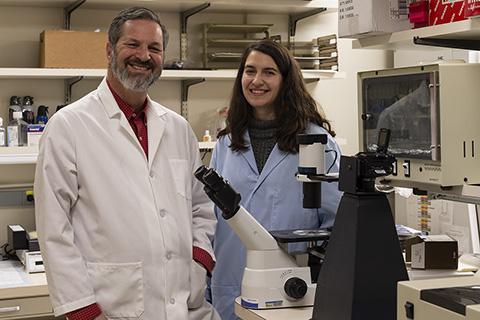Dennis Klinman, M.D., Ph.D., says science is like the surface of a sphere—there are thousands of possible connections between different points. It is fitting, therefore, that on the eve of his retirement, the senior investigator has helped a young scientist connect with her passion.
Thanks to a two-year fellowship with Klinman, Begum Horuluoglu, a Ph.D. candidate at Bilkent University in Turkey, discovered her fascination with treating autoimmune diseases by targeting the immune system. She recently made it the subject of her dissertation, which she hopes to submit this summer.
Klinman’s NCI at Frederick laboratory, a cross-disciplinary section of the Cancer and Inflammation Program, focuses mainly on the immune system’s role in disease but also offers fellows a wide latitude to pursue their research interests in that area. Past fellows often studied cancer, but some, like Horuluoglu, later researched autoimmunity, a critical medical need with relevance to cancer research. (Autoimmune diseases, such as lupus and rheumatoid arthritis, occur when the immune system attacks the body’s other cells.)
“It’s very inspiring to be here,” Horuluoglu said. “If I want to pursue a project that I have in mind, [Dr. Klinman] motivates me.”
Klinman’s approach to running the lab stems from his “sphere” philosophy. As a physician-scientist who has spent decades connecting the dots between the immune system, cancer, and autoimmunity, he recognizes the value in approaching scientific questions from multiple angles.
Case in point: Horuluoglu found her passion while working on an autoimmunity study that originated in cancer research. While seeking molecules that could stimulate immune cells to attack tumors, Klinman’s lab identified PAM3, a molecule that helps generate cells that suppress immune activation. Realizing that it held potential for treating autoimmune diseases, Klinman asked his team to consider studying the molecule.
Horuluoglu joined the study and eventually co-authored a paper with Defne Bayik, Ph.D., (who is now at the Cleveland Clinic) that demonstrated PAM3’s ability to generate suppressive cells in blood samples of lupus, myositis, and vasculitis patients and to suppress manifestations of lupus in live mice.
The team showed that PAM3 stimulates certain cells in the blood to develop into complex immunosuppressive cells, preventing them from becoming dysfunctional inflammatory immune cells that contribute to autoimmune diseases. Ill mice treated with PAM3 had near-normal levels of inflammatory cells, less kidney damage (a hallmark of lupus), and significantly longer life spans than their untreated counterparts.
“We thought it was very exciting because [PAM3] could be used in combination with other cell-targeted therapies in the treatment of diseases like lupus,” Horuluoglu said.
Connections Past, Present, and Future
As the head of the lab, Klinman found the team’s results rewarding—but he found mentoring its members, especially Horuluoglu and Bayik, equally gratifying.
“[I] speak highly of both of them. Both Defne and Begum [were] hardworking and creative,” he said.
Mentorship has long been at the center of Klinman’s career, and he takes the privilege seriously, something he learned from his many mentors.
One of his biggest influences was Alfred Steinberg, M.D., a National Institutes of Health scientist and autoimmunity researcher who led the laboratory where Klinman completed his postdoctoral fellowship.
“He was very demanding, very rigorous, and very caring,” Klinman said, adding that Steinberg tried everything he could to help his fellows succeed.
Klinman tries to follow Steinberg’s example. Though he admits he isn’t always successful, he strives to help his fellows attain their goals, and his flexible and cross-disciplinary approach to running the lab is patterned after Steinberg’s own mentorship.
June marks the end of Klinman’s decades-long tenure at the National Institutes of Health, which has spanned rheumatology, autoimmunity, biologics, and cancer. He regrets not finding a definitive cure for cancer, his hope while at NCI, although he made major contributions during his career—he and Arthur Krieg, Ph.D., discovered CpG oligonucleotides, immunostimulatory molecules that have since been used in cancer therapies and FDA-approved vaccine adjuvants.
Klinman isn’t sure what direction the research he initiated will take after he retires, but he’s confident others will find a path linking different points across the scientific sphere.
“I may think that the shortest distance between two of those points is a particular series of studies, and another laboratory may also want to link those two points and take a completely different route,” he said.
He also takes comfort and pride in knowing that his former fellows will carry on, if not in the same line of research, at least in spirit. After Horuluoglu submits and defends her dissertation, she will obtain her Ph.D. and begin her postdoctoral scientific career. She plans to continue researching autoimmunity and hopes to work in an academic laboratory.
“I’m really happy that I came this far, and I’m thankful to Dr. Klinman for that,” she said.


